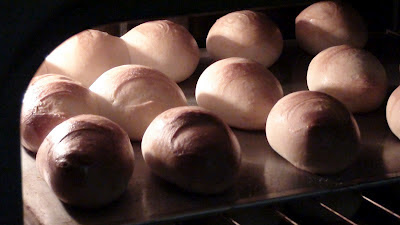For starters i cannot make this Hard Monay if i did not bring any 3rd class flour or soft weak flour to New York. Once i ran out of 3rd class and tried Cake Flour, it turned bad, do not even think of using All Purpose, it will be soft but not chewy as this one made with yes, 3rd class indeed.
So third class is hard to find here in the US if you will use that term. You have to say or look for soft wheat flour, that's it, not hard wheat flour, not cake or All purpose but something in between these two. It is easy to find in the Phil., just ask your local bakery suppliers and they know it is Tercera.
Tercera is not for bread, bakers use it basically for cookies, cakes and other pastries, but we bakers know how to create bread recipes using part of this flour with the bread flour or hard wheat flour. It makes a softer version of any of your fave breads, with a cheaper price tag. Plus if i own a bakery, i get to use the third class for my cakes and cookies, lowering my food cost in the end. Both Cake and All purpose flours are expensive, third class is at least 15 pesos cheaper.
Here, i baked a batch of Hard Monay which is a favorite amongst my students, it is chewy, sweet, milky and filling. Just dunk it in hot coffee and you are good to go.
Sugary top, delightfully Pinoy. Hard Monay, if you proof it longer, it will taste the same but will be bigger of course, and not as siksik or fine in texture.
Be sure to catch up with my baking lessons if you want to learn how to start a bakery, my classes will start this October 15, 17 and 19. Only 7-8 students will be accepted.
www.breadmakinglessons.com
So how do we really do the Baston style "singkit" cut? First start with a slightly stiff dough, if your dough does not have eggs or eggyolks, a hydration of around 55% is ideal. I have seen bakers use less water, but that will make your Pandesal too dry and dense after 1 day or so so try to keep it slightly on the soft side, but not too sticky. Why? If you use a sticky dough for the Baston style cut, the dough will spread and will have a flat look rather than a rounded shape we are all familiar with. In Tagalog, "lalapad" ang dough so medyo flat ung Pandesal. So after you mix the dough, divide it into 2 to 4 portions if you are mixing kilogram. Experienced bakers divide their dough into 500 gram portions, i do mine the same way. Flatten the dough, focusing more on the length and not on the height. The height of the dough should be around 2 to 3 inches only. Next, fold the dough while pinching the edges making sure the dough surface ...






Comments
albert manuel
2nd class is all purpose flour because its consistency is between the bread and cake flour
3rd class flour is also called cake flour use for cakses,
It's not exactly "cake flour" which has an even lower protein content, i.e. lower gluten formation.
I suppose, if you need to rank them gluten-wise, it will be:
1. Bread flour (1st class)
2. All-purpose flour (2nd class)
3. Pastry flour (3rd class)
4. Cake flour (I have never seen this referred to as 4th class anywhere, it's just usually called cake flour).
For more detailed explanation of the different types of flours, one of my go-to references is https://www.seriouseats.com/2020/07/wheat-flour-guide.html
2nd Class Flour - All Purpose Flour (Everyday Bake Value)
3rd Class Flour - Pastry Flour (Soft Wheat Flour) (i.e. Cookies, Crackers, Biscuits, Cupcakes etc.)